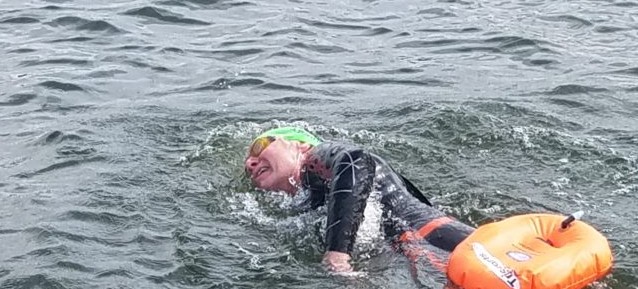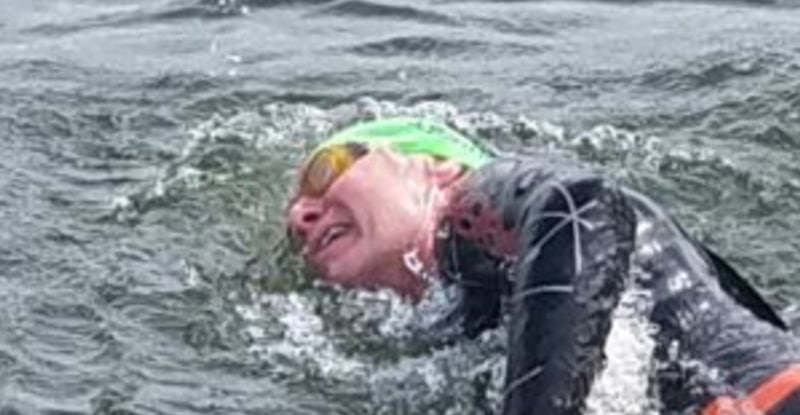Learning to Swim for Triathlon – Breathing Correctly

‘Breathing correctly while swimming is a pre-requisite for a relaxed and efficient swim stroke. It’s also the foundation of a confident triathlon swimmer.
Learning to Swim for Triathlon
Since I learned to swim around the time I began grade school, I was initially surprised to hear about the many over 50 who have never learned to swim. However, it is truly never too late to learn to swim. In fact, you should learn to swim for all its benefits.
Most who struggle with learning to swim, including my mother and my aunt, swear they were simply not ‘made’ to swim. When pressed on this, they admitted their difficulty learning to swim was rooted in their inability to ‘catch’ their breath.
The literature on swim training is full of support for the premise that breathing correctly during the swim is the first and most fundamental skill to master on the road to becoming a confident swimmer. It is only after we have developed a means of taking in oxygen needed to fuel our muscles during swimming that we can work on other parts of the technique.
The confidence that comes from relaxed breathing during the swim will also help us deal more effectively with the unknowns that can and often do occur during a triathlon.
Why Breathing While Swimming is Challenging?
The swim strokes commonly used in a triathlon require breathing with our face in the water a majority of the time. This is certainly true of the fastest and most popular stroke for the triathlon swim, the front crawl, sometimes referred to as freestyle.
For this stroke, our face, nose, and mouth will be in the water during most of the stroke. This is especially true if we maintain a proper body position. With a correct position, our head will be in line with our spine in order to maintain balance in the stroke.
Even the breaststroke, used by some triathletes, involves the face being underwater a good deal of the time.
While it is possible to swim with our head out of the water, at least for shorter swims, this body position leads to extra drag as our legs drop in the water. It can also lead to fatigue of the neck muscles. Greater fatigue during the swim will affect the other legs of the triathlon.
Controlled Breathing Starts With Base Fitness
The more relaxed our breathing is during the swim, the more we can focus on the stroke and on maintaining control of body position in the water.
There are two principal contributors to controlled breathing: (1) fitness and (2) breathing technique in the water.
Let me start with the first one – fitness.
We all know that when starting to exercise after being away from it for a while, our breathing becomes labored and our heart rate becomes elevated more quickly than when our fitness increases. Our bodies are not as efficient in using oxygen as they will be when we become more fit.
It is well documented that the amount of power we generate at a given heart rate increases as we become more fit.
My own experience has been that when I resume swimming after a period of low activity (low aerobic fitness), my heart rate will often spike when I push myself to swim faster.
When that happens, I am forced to slow or even stop momentarily. This doesn’t give me confidence as a swimmer.
For this reason, I suggest that before starting to swim, you develop a base level of fitness through combined walking and running or other aerobic exercise, such as water aerobics, using the approach described in this post on building a base level of fitness.
What Makes for Proper Breathing During the Swim
We rarely pay attention to our breathing when we are on land. We may be more aware of our breathing when running, biking, or performing other strenuous activities. However, even if conscious of our breathing, we notice it is a more or less continuous process. We are continually either inhaling or exhaling.
Why then do people hold their breath while swimming, expecting to almost instantaneously exhale and inhale? It doesn’t work. And breathing incorrectly becomes even more apparent as we swim for a short while and our body’s demand for oxygen ramps up.
When learning to swim, breathing must be conscious. It must involve proper amounts of inhaling and exhaling. The challenge is that the ratio of inhaling and exhaling is not natural. Neither is the environment. That’s why we need to learn to breathe in the water and to do so with ease.
For the rest of this post, I will assume that you will learn to swim using the forward crawl stroke, the one most commonly used for the triathlon swim.
Inhale quickly through the mouth
Inhaling during the swim stroke occupies a small portion of the breath. Tilting our head to one side periodically so that our mouth is out of the water gives us time to take a quick breath of air. Even if a little water gets into our mouth during this process, it is not a problem since our mouths are designed for taking in water as well as air.

Exhale through the mouth and nose until ready to inhale once again
Exhaling is where most of the difficulty occurs. Unless you have exhaled all or nearly all the contents of your lungs, the amount of oxygen you can take in when inhaling will be limited. For this reason, exhaling through both the mouth and nose should begin immediately upon completing the inhale portion. Continue exhaling until beginning to inhale once again.
Remember to exhale through both the mouth AND nose. Most of the exhaled air should, however, pass through the mouth.
Exhaling through the nose alone has two limitations. First, it is nearly impossible to exhale an adequate amount of carbon-dioxide rich air during the short period of a single stroke.
Secondly, forcing as much air out of the nose as possible forces germ-laden water droplets from the throat into the nasal passage and other portions of the sinuses and ears. Water trapped in these parts of the body can be irritating, even unhealthy.
Triathlon Tip: Do you struggle with water in your nose during swimming? According to USAT officials, it is legal to use nose plugs and even a face mask during a triathlon swim. For more information, check out this related post: Product Review: Nose Clip for Triathlon Swim Training.
Never hold your breath
If you are having difficulty breathing while learning to swim, stop and observe. Is there any time in the stroke during which you hold your breath? Never hold your breath! Always be either inhaling (while your mouth is out of the water) or exhaling.
Learning to Breathe Correctly While Swimming
I hope that I have convinced every new swimmer preparing for a triathlon to begin their swim training by learning to breathe properly.
At this stage, it is critical that you keep yourself safe by avoiding water too deep to stand in. With this ‘safety first’ goal in mind, here are two options for developing your breathing technique.
On Your Own – With a Friend Who Can Swim
While getting lessons from a professional swimming instructor is best, you may not have access to one because of where you live. Or, your fitness or community center may not offer lessons.
You can develop confidence in breathing during the swim on your own. However, at this stage in your swimming development, don’t go into the pool without an observer (lifeguard or friend who remains on the deck watching you).
First, practice breathing while standing in the water. Put on your swimming goggles (and nose and earplugs if needed). Put your face in the water and exhale simultaneously through your mouth and, if not using a nose plug, your nose.
When you have exhaled nearly all the air, roll your head to one side until your mouth is just out of the water. Quickly take a breath, roll your head back into the water, and begin exhaling. Repeat this process several times.
For this exercise, you can rotate to the side on which you are most comfortable. However, after a while, you will want to become comfortable breathing on either side. You will understand later, especially during an open water swim on a sunny or windy day, why this additional flexibility in your swim stroke is valuable.
Note that breathing while moving through the water will be easier than when standing still. As the picture above shows, water flows around the body as we move through it, creating a depression around our face. As a result, you can take a breath with one eye (goggle) underwater.
Next, grab a kickboard
Once comfortable with the rhythm while standing, you can grab a kickboard. Hold it with your arms extended in front of you. Extend your body in the water while maintaining a straight spine. Keep your butt, legs, and feet near the top of the water.
Kick along the length of the pool practicing breathing – inhaling and exhaling. Continue to exhale until your mouth is out of the water enough to grab a quick breath.
Try to avoid lifting your head when rotating it to take a breath. Be aware that the kickboard will keep your arms and head higher in the water than when swimming without it.
Once you are comfortable kicking and breathing, you can hold the kickboard with one hand, alternating hands as you use the other to pull through the water.
These techniques are demonstrated in this video.
Join an Adult Swim Class at the YMCA or Your Fitness or Community Center
I learned to swim well when I was young. However, the quality of my swim stroke and my confidence as a swimmer jumped to a new level through the help of one of my kid’s YMCA swim coaches. He had watched me swimming laps and gave me a couple of pointers related to breathing that I have included above. These simple tweaks to my breathing changed my swim.
Safety First – Save the Open Water for Later
There are several advantages of starting to swim in a pool.
First, and probably most important, is that you can control the depth of water you are in. Many pools have a depth in which you can safely stand. If there are deeper sections, it is easy to see where the depth increases to avoid these.
Many pools also have lane dividers, ropes with or without discs, running between individual lanes. You can hold on to these if it becomes necessary to stop in an area too deep for standing.
These favorable conditions do not typically exist in open water. In most cases, it will be difficult to see the bottom and gauge the depth of the open water.
Related post: Triathlon Swim–How Does a Pool Swim Differ from Open Water?
Where Do You Go From Here in Learning to Swim for Triathlon?
As with learning most new skills, patience is a virtue. Keep working to become comfortable breathing with your face in the water.
Once you have achieved this, you are ready to move on. In the next phase, you will develop your form in each of the parts of the stroke. This will set the stage for more effective training and further confidence-building increases in speed and distance.
Leave Your Questions and Comments Below
Leave your questions about breathing while swimming in the Comments below. To the experienced swimmers and swim coaches reading this post, what would you add to my comments?
Comments: Please note that I review all comments before they are posted. You will be notified by email when your comment is approved. Even if you do not submit a comment, you may subscribe to be notified when a comment is published.
